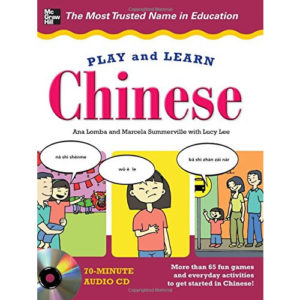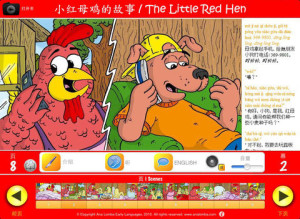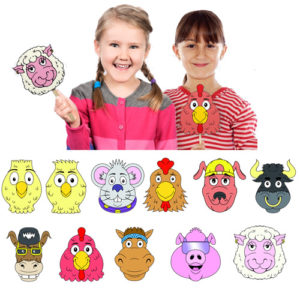Ana Lomba’s Chinese for kids products introduce a fun way to help children learn Mandarin Chinese fluently, through everyday activities, play, bilingual stories, and printable props.
Why Chinese for Kids Products Are a Fantastic Way to Learn
Language products should make learning fluent Chinese (Mandarin) fun in a natural way. The way native Chinese children learn through talk, play, and stories.
Learning fluent Chinese is not about isolated exercises, like memorizing colors, numbers, and animals.
Instead, learning a language in the context of everyday activities, play, and through storytelling are powerful learning strategies for fluency.
Make Learning Chinese Fun through Everyday Activities!
 Our Play and Learn Chinese with Audio CD is especially designed for parents who want to immerse their children (and themselves) in fluent, everyday Chinese (Mandarin).
Our Play and Learn Chinese with Audio CD is especially designed for parents who want to immerse their children (and themselves) in fluent, everyday Chinese (Mandarin).
No drills and boring grammar exercises.
Instead, you get tons of activities, comic strips, fun games, and songs that let you seamlessly integrate the Chinese language into your everyday life.
There are English translations for all the activities and sidebars with fun cultural information.
Note: this book is available in Kindle.
Use Storytelling
Storytelling is another fantastic strategy to advance quickly in Chinese. Why? Because in the process of learning to do lively readings or act out stories, you are intensifying the development of oral and literacy skills.

Combining language skills makes a huge difference—and boy, is it fun!
However, not all story-based materials are created equal. Ours are bilingual.
We have designed our classic stories specifically for adults and young children learning Chinese together. They are great for older children, adults, and classrooms, too.
The subscription and the apps include the following bilingual titles:
- The Little Red Hen
- Cinderella
Key Features of Ana Lomba’s Classic Bilingual Stories:
- Voice-over by native actresses for captivating effect and to help you model animated speech.
- Easy toggle functionality between Chinese and English (or another language) so you can quickly check the meaning if you get lost—you could also alternate reading in the two languages if you so please.
- “Pause” button so you can stop and replay shorter chunks of the text.
- Scene divisions so that you can concentrate on one section at a time and for easier reenactment.
- Vibrant comic-style illustrations, providing strong non-verbal cues to reinforce comprehension and make the experience very enjoyable.
- Tons of everyday language and dialogue at a kid’s level for easy transfer to daily parent-child interaction.
Use Our Poster & ToonFlips© Printables as Additional Storytelling Aids

Use the posters to generate conversations about the characters or however you like.
ToonFlips© are illustrations meant to be used as quick-acting cues. You can use them to indicate who is talking, the location where the action is taking place, or other important elements.
The applications are only limited by your imagination.
After Purchasing, What Should You Focus On?
- Personal interaction. Children learn languages best through personal interaction. This is why it is important that you, the parent, join in the adventure. [Note: older children and adults can use the stories independently, but I still recommend to have a learning buddy.]
- Animate your story reading/telling sessions. Make pretend voices, act out some parts, wear wigs… make the sessions as animated and lively as possible! Use our printable ToonFlips© and posters for additional inspiration.
- Use your Chinese! Make the point of using the Chinese that sticks with you (more each time) in your daily conversations with your child. Also, do NOT worry about speaking with perfect grammar and pronunciation. Actual usage is more important at this point.
For Even Greater Results with Your Chinese “Lessons”:
- Play the stories frequently. This is both to train your ear to the flow of real Chinese in action and also to imprint large volumes of Chinese grammar, intonation, cultural flair, etc., in your brain (a lot of this process will take place unconsciously!)
- Set personal learning goals. For example, “This week we will learn at least five new expressions.” Challenge yourself as you become more strategic in your learning. It’s a good idea to keep a language-learning journal and look back at all the progress that you have made—don’t forget to pat yourself on the back!
With my portfolio of Chinese for Kids products, your children will be on their way to learning fluent Chinese.
Also, do I need to be a teacher to start a language Family Daycare in my home? Would it be possible for me to teach Spanish, Mandarin and English or will it be too much for my children?
Frankly, in a small family daycare setting I would prime quality and offer the best immersion experience in one, maximum two languages.
Good afternoon, I am interested in teaching Mandarin for children. I see you have a lot of Chinese material do you have the information in mandarin as well?
Hi Sharon,
The e-storybooks are completely bilingual, so you can read them in one language or the other. They are available from my website (as a subscription for computer users) or as iPad apps (from the iPad app store) or Android/Kindle apps (from Amazon.com). The book Play and Learn Chinese is written in English with the examples in Mandarin (characters + pinyin).
I’m a 40 year old man who would like to learn how to speak and read the Chinese language but don’t know where to start. any advise?
Arthur, while my stories are meant for children, many adults use them to learn as well. You can try them out and see (they are also available as iPad apps, if you have an iPad). Also, my book Play and Learn Chinese is meant for parents who do not speak Chinese. You may or may not have kids, but the book will help you learn a lot of everyday language anyway. It comes with a CD. I believe that you can see some inside pages on Amazon: http://amzn.to/Nq1q1t
BTW, do not buy the Kindle version – it comes without the recording, and of course you need to hear the language! 🙂
My Chinese collaborator for Play and Learn Chinese, Lucy Lee, is a candidate to world language teacher of the year 2012, and the voices are native Chinese actors.